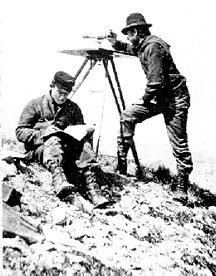Wednesday, January 28, 2009
 Initially charged by Congress with the "classification of the public lands," the USGS began topographic and geologic mapping in 1879. Most of the early USGS mapping activities took place in the vast, largely uninhabited Western United States.
Initially charged by Congress with the "classification of the public lands," the USGS began topographic and geologic mapping in 1879. Most of the early USGS mapping activities took place in the vast, largely uninhabited Western United States.
Extreme challenges awaited these mapping pioneers. Travel was arduous and costly. Many locations could be reached only by mule pack train. Furthermore, surveying and mapping instruments were crude by today's standards. Most maps were made using a classic mapping technique called planetable surveying.
Planetable surveying took great skill and, depending on the mapping site, equal daring. Carrying a planetable—essentially a portable drawing board on a tripod with a sighting device--the topographer would climb to the area's best vantage point and carefully plot on the map those features that could be seen and measured in the field. Planetable surveying remained the dominant USGS mapping technique until the 1940's, when it gave way to the airplane and the age of photogrammetry.
Subscribe to:
Post Comments (Atom)










0 comments:
Post a Comment